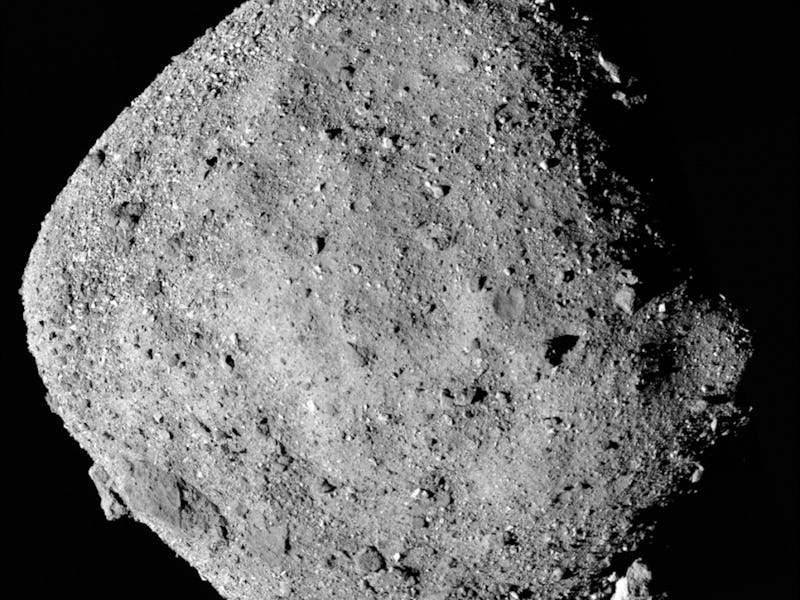Bennu and Ryugu may have come from the same asteroid collision
A new study explains their odd spinning-top shapes.

Approximately 600 million kilometers from Earth, fragments of rock are scattered in an orbit around the Sun, roughly between the orbits of Jupiter and Mars. The asteroid belt contains millions of oddly shaped rocky bodies, and some of them make their way closer to Earth.
Asteroids Bennu and Ryugu are two such near-Earth asteroids, famous for their irregular spinning-top shape. And a new study suggests that they came from the same region of the asteroid belt as a result of a major collision, and may have even broken off from the same parent body.
The study, published this week in the journal Nature, traces the origin of these two asteroids with the aim of getting a better picture of our own origin story and how life started here on Earth.
Bennu vs. Ryugu
The two asteroids are in a bit of a cosmic rivalry, seemingly competing with one another for the spotlight.
Asteroid Bennu is a near-Earth Object with a diameter of approximately 500 meters (which is about 3/10 of a mile). It orbits around the Sun every 436.6 days and comes within a close distance of 0.002 AU from Earth every six years.
The asteroid was discovered in September 1999 and is currently the target of NASA's OSIRIS-REX mission, which will return a sample of the asteroid to Earth by the year 2023.
Meanwhile, asteroid Ryugu was discovered in May 1999, measuring around 900 meters in diameter. The potentially hazardous asteroid is on an elliptical orbit around the Sun every 16 months, where it happens to cross the orbits of Earth and Mars.
Brief moments of the spacecraft's landing on the rocky asteroid.
Ryugu is the target of another asteroid sample mission. The Japan Aerospace Exploration Agency's (JAXA) Hayabusa2 spacecraft touched down on the asteroid on February 21, 2019, and is on its way back with a sample of Ryugu.
Hayabusa2 is expected to land back on Earth in December 2020.
Another thing these two asteroids have in common, they both share an odd diamond shape, not typical of other asteroids scientists have observed.
Patrick Michel, director of research at the French National Centre for Scientific Research, and lead author of the new study, was already pretty sure these two asteroids were related but wanted to prove his hypothesis.
"We were actually looking for this solution before finding it," Michel tells Inverse. "We needed a scenario that can explain their formation."
A rocky origin story— The team behind the new study designed numerical simulations of large asteroid collisions that would have taken place in the asteroid belt. The simulations resulted in fragments that broke off from a larger parent body, reaccumulated, and formed a different rocky body with a spinning-top shape similar to Bennu's and Ryugu's.
An animation showing the formation of an aggregate by the reaccumulation of fragments produced during the disruption of an asteroid.
The study also suggests that Bennu and Ryugu could have broken off from the same parent body seeing as how they both originated from the same region in the asteroid belt, and have a similar shape and width.
The asteroids, however, do differ on one thing. Bennu and Ryugu have different hydration levels, which the researchers attribute to two possible scenarios. Either the asteroids broke off from two different parent bodies, and therefore each reflects the hydration level of the larger rock, or they came from the same parent body but experienced different evolutions.
A recent analysis of footage of the asteroid Ryugu collected by the Hayabusa2 spacecraft noted that the asteroid's surface is made up of two different types of material that vary in color, with one being slightly red and the other being slightly blue.
Scientists believe that this change in color is due to heating caused by the Sun and that Ryugu may have gotten a little too close to the star at some point during its early history.
Therefore, Ryugu could have become more heated than Bennu, resulting in different hydration levels between the two asteroids.
"Whether it’s the same parent body or not, our simulations show that it could be the same but doesn’t have to be," Michel says.
Michel and his team are eagerly awaiting results from the two asteroid sampling missions in order to form a better idea of the formation age of the two asteroids and to verify whether the material that makes up the asteroids is the same material found on Earth.
One leading theory of how life began on Earth is that it was transported here by way of rocky asteroids that crash-landed on our planet during its early history. Therefore, learning more about the origins of these rocky bodies could answer one of life's burning questions; where did it come from?
Abstract:Asteroid shapes and hydration levels can serve as tracers of their history and origin. For instance, the asteroids (162173) Ryugu and (101955) Bennu have an oblate spheroidal shape with a pronounced equator, but contain different surface hydration levels. Here we show, through numerical simulations of large asteroid disruptions, that oblate spheroids, some of which have a pronounced equator defining a spinning top shape, can form directly through gravitational reaccumulation. We further show that rubble piles formed in a single disruption can have similar porosities but variable degrees of hydration. The direct formation of top shapes from single disruption alone can explain the relatively old crater-retention ages of the equatorial features of Ryugu and Bennu. Two separate parent-body disruptions are not necessarily required to explain their different hydration levels.
This article was originally published on